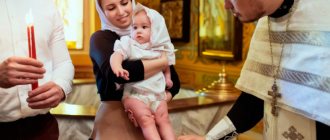Choice of godparents and date
There are no clear deadlines that parents must meet. There are those who believe that a child should grow up and make his own decision about religion. But most try to carry out the ceremony until the moment when the baby begins to distinguish between “friends” and “strangers”.
According to church canons, it is recommended to baptize on the eighth or fortieth day from birth. At this age, no one will demand faith and repentance, so all responsibility rests with the godparents.
These people are blood relatives or close family friends. It is important that a person becomes a support and support for the child, a mentor on the path of life. But even with such a wide choice of options, take into account certain nuances:
- spiritual parents must be Orthodox;
- so that there are two of them. Preference is given to adults, but the minimum age for a recipient is 13 years;
- future godmothers should not be in a romantic relationship;
- A woman who became a mother a month ago cannot take part in the ceremony.
Basic Church Requirements
Baptism is the first and most important sacrament of Christians. Through baptism a person becomes a member of the church and receives admission to other sacraments. The Russian Orthodox Church does not set a minimum age for religious conversion. At the initial stage of Christianity, baptism took place in a different order from the modern one. They prepared for it in advance, for several months. During this time, converts underwent a test of faith (fulfilling the commandments), learned the basics of Christian teaching, and performed rituals.
The introduction of the sacrament of the godparents into the ritual appeared when Christians were persecuted and were forced to hide their religion. The godfather was a religious man who knew closely the person who wanted to join the Christian faith. He was a guarantee to the Christian community that the person was sincere in his religious intentions. He was entrusted with the preparation for the announcement and he was required to be present at the sacrament.
The announcement took place in the church: the clergyman named by name the people who were allowed to attend services before baptism, with the exception of the sacrament of Holy Communion.
Among Christians of this period (II-IV centuries) there was a belief that during baptism all past sins were forgiven. For this reason, people tried to be baptized as late as possible. The Church fought against this superstition. When Christianity became the leading religion, they began to try to introduce them to the sacrament from infancy.
Since the child was not able to fulfill the conditions of the ritual, his godfather/godmother began to perform this for him. In 397, the Council of Carthage approved the rule according to which Christian parents who did not agree to baptize their infants were anathematized (excommunicated from the church).
The rite of announcement began to quickly be replaced by the baptism of babies. The timing of the rites of passage for infants and minors has varied throughout the millennia of Christian history. The Gospel of Mark quotes Jesus as saying that he who believes and is baptized will be saved (that is, the convert must be aware of his actions at baptism).
Gregory the Theologian explains his attitude to the baptism of children: if there is a danger to health, then they are baptized from the first days of life; for healthy children - baptism at the age of 3, when the child will be able to repeat after the priest and understand the words of the prayer.
Currently, clergy recommend that parents baptize their children as early as possible, so as not to frighten the child with an unfamiliar environment and a stranger who takes him in his arms and performs incomprehensible manipulations.
The Russian Orthodox Church has retained the procedure of announcement before baptism. Newly converted adults and children over 7 years of age are required to take it. When performing baptism on infants and children under 7 years of age, both parents and recipients must undergo preparation.
The child's godparent must be an Orthodox Christian. Atheists and people of other faiths (Muslims, Buddhists, Protestants, Catholics) are not allowed to participate in the rite of Baptism. The successor to the relatives of the father and mother must not only be baptized in Orthodoxy, but also attend church services, adhere to rituals and traditions, and know the basic prayers.
An Orthodox father and mother cannot be godparents for their children at the same time. A married couple cannot be godparents to one child. Consent to spiritual kinship must be conscious, since it means participation in the upbringing of the godson.
For this reason, minors cannot be appointed as foster children. Before the sacrament of Baptism, the priest can clarify how old the future godparent is. A minor baptized in Orthodoxy can be a spiritual guardian if he understands his responsibility before God.
Preparing for the baptism ceremony
To comply with all the rules, you will have to work on your body and spirit.
The recipients must visit the temple, confess and receive communion. The priest will tell them what moral guidelines godparents should instill in their child. Before the ceremony, they learn the “Creed” prayer. When it is performed over a girl, a woman will read over a baby, and a man over a boy. According to custom, the godfather buys a kryzhma (a piece of linen or a towel in which a newborn is wrapped after immersion in the font). She gives a baptismal shirt and cap. Traditionally the colors are blue and pink, but any other is possible, at the discretion of the godmother. After the ceremony, the kryzhma is not washed. During illness, they cover the child’s head with it and read a prayer.
Now there is a wide selection of outfits for children, but a dress that you made with your own hands will be valuable. The fabric will preserve the energy of the spiritual mother and better protect the child. According to superstition, in large families this shirt is passed down “by inheritance.” The priest receives a silk scarf from his godmother.
The godfather acquires a chain and a cross. The material for it depends on the wishes of the parents - gold, silver or wood with a ribbon. Other expenses are also borne by the godfather. Nowadays, this is most often done by the family of the newborn. In the old days, gifts were given to both the child and both mothers.
How to baptize objects correctly?
How to baptize objects correctly?
The sign of the cross has great power; it must be done with faith and trust in God's help. To know how to properly baptize objects, you need to have a general understanding of how to apply the sign of the cross. When a person baptizes himself, that is, makes the sign of the cross, he needs to put three fingers together - the thumb, index and middle, the remaining two fingers, that is, the ring and little fingers, need to be pressed to the hand. With three folded fingers, a person first touches his forehead, then his stomach, then his right shoulder and then his left shoulder, thus depicting the Cross of the Lord on himself. When applying it to your body, as well as to other objects or people, you need to say: “In the name of the Father and the Son and the Holy Spirit. Amen,” with this we confess our faith in the Holy Trinity. Three folded fingers symbolize the three faces of the Holy Trinity: God the Father, God the Son and God the Holy Spirit. The two fingers pressed to the hand symbolize the two natures of our Lord Jesus Christ, Divine and Human. When the sign of the cross is applied with faith, evil forces retreat, temptation passes and the Lord sends His life-giving help.
When we baptize objects, we need to make the sign of the cross over them, pronouncing the same words as when applying the sign of the cross to ourselves. To depict a cross on any object, we first cross it upward with the words: “In the name of the Father,” then downward with the words “And the Son,” then to the left with the words “And of the Holy Spirit,” and then to the right with the words "Amen". You need to make the sign of the cross slowly and reverently with prayer to the Lord.
How to baptize people correctly?
In many Orthodox families, it is customary for the mother and father to bless their children with the sign of the cross before they leave the house. The child turns to face the mother or father, who baptizes them. First they touch their forehead, then their stomach, then their right shoulder and then their left shoulder. With such a blessing, parents pray that the Lord will protect their child and protect him with the power of the sign of the cross. The Cross of Christ and its image have unspeakable power; it has more than once delivered people from various troubles, sorrows and even death. Christians apply the sign of the cross to themselves, other people and surrounding objects. To know how to baptize people correctly, you just need to know how to be baptized yourself. In this text we use the word “baptize” in the meaning of “to make the sign of the cross.”
How to properly baptize food?
Before eating food, it is customary to say a prayer, for example, “Our Father” or an excerpt from the Psalm, which is called “Prayer before eating food.” After saying this prayer, the food is marked with the sign of the cross so that the Lord will bless the meal. To know how to properly baptize food and not make mistakes in this process, you need to put everything that you are going to eat on the table. Then, turning their face to the icon, which is usually hung on the wall not far from the table, they say a prayer. Then, looking ahead, they make the sign of the cross, making the sign of the cross first on the top of the table, then on the bottom, then on the left and right sides. The fingers should be folded in the same way as when applying the sign of the cross to a person. You need to say out loud or mentally the same words as in any case when you baptize yourself or other objects. By making the sign of the cross, Christians invoke God's grace and blessing on their meals. The Lives of the Saints describe amazing cases when even the poisonous substances with which ill-wishers wanted to poison the saints of God lost their potency after they were crossed with the sign of the cross. The person who prays before eating and baptizes his food is much less susceptible to such sins as overeating and gluttony. In addition to harm to the soul, these sins and passions harm human health.
How to cross corners correctly?
Believers often make the sign of the cross not only themselves, but also everything that surrounds them. After the fall of the first people, evil forces became capable of harming people. Often we may not see evil spirits, and may not know why our troubles, temptations and bad mental states occur. The more often a person baptizes himself and everything that surrounds him with faith and prayer for God’s help, the easier it will be for him to walk along the road of salvation. How to cross corners correctly can be concluded from how to correctly apply the sign of the cross to other people and objects. You need to turn towards that corner and make the sign of the cross in front of you, first, in the air, make an image of the top of the cross, then the bottom, then the left side and finally, the right side. At the same time they say the words: “In the name of the Father and the Son and the Holy Spirit. Amen". The sign of the cross is always applied with the right hand; in addition to these words and applying the sign of the cross, you can read a prayer calling on the Power of the Cross of the Lord or other prayers. They ask the Lord to protect us with the Power of the Life-Giving Cross and protect us from all evil. You can read Psalm 90 or other Orthodox prayers according to your desire and the call of your heart. You can also pray in your own words, but be sure to wish spiritual salvation to all people. May the Lord make you wise and preserve you with the Power of His Life-Giving Cross.
Author of the article: Ksenia Orabey, theologian and religious scholar
Christening of a child - how the ceremony takes place
In order for everything to go smoothly, adult participants in the ceremony need to familiarize themselves with the “regulations” in advance. Parents with the baby, godmothers and guests arrive at the church in advance so that they do not have to delay the priest. Before the appointed time, a certificate is filled out, the ceremony is paid for, and an icon depicting the patron saint of the newborn is purchased.
The child is undressed, wrapped in a clean diaper, and after a sign for the beginning of the sacrament, he is brought into the temple. The girl is held by her godfather, and the boy by her mother. The priest places his hands on the child as a symbol of protection and intercession before God.
The recipients, together with the baby and candles, stand around the font. They read the Creed, renounce evil, and take an oath to fulfill their duties. The church minister takes the baby and dips him three times in blessed water. After this, the child is smeared with myrrh on his forehead, eyes, nostrils, mouth, ears, chest, arms and legs.
The newborn is then handed over to a godfather of the same gender. The parent wipes the child, puts on a cross and a shirt. The priest cuts the locks from the top of the baby's head. This is the sacrifice that the young soul gives to the Savior for cleansing. The anointed baby is carried around the font three times. At the end, the boy is carried across the altar, and the girl is placed next to the icon of the Mother of God. The whole procedure takes from half an hour to two.
Signs for baptism - celebration and gifts
It is not customary to organize large meals on the occasion of church service. Relatives, friends and godfathers are invited to tea. In addition to the usual treats, the hostess puts on the table a cake with the child’s initials and the date of the christening.
A traditional gift for confirmation was a measured icon. This was ordered to match the size of the baby. The newborn was presented with the Gospel and a children's Bible.
The older generation of the family gave a silver spoon. They tap it on the first erupted tooth to prevent pain. Afterwards it became an ordinary cutlery. In some cases it was passed down by inheritance.
Other gifts are given based on the baby's needs. Ask parents what the child needs. This rule applies to godparents and other guests. Universal - toys, but it all depends on the specific situation.
Popular signs for a child's baptism
There are many superstitions that cover the period “before”, “during” and “after” christenings. How to treat them, everyone decides for themselves. The Church does not condemn, but does not welcome enthusiasm for folk superstitions. According to ancient tradition, the child's biological parents have no right to participate in the ceremony. The mother generally waits for the completion of the ceremony outside the church gates.
Superstitious women, in order to protect the baby from the evil eye and damage, do not show his face to strangers. They curtain the stroller and do not post photographs of the image to the public. Surprisingly, such tactics are approved by the clergy. As if before baptism the child is not covered by heavenly protection, he is more easily exposed to the influence of negative energy.
To celebrate the moment on the day of christening, the baby is put on new clothes. It symbolizes renewal and a second spiritual birth. But this is optional. The parents also look modest and neat. No provocative cuts or tacky colors.
According to an old tradition, a churchgoer is transferred to his father’s house through a window. The authenticity of the ritual is questionable. And for a resident of an apartment building it is impossible. According to another version, a similar reception is carried out during re-baptism. Then the parents transfer the child into the hands of their godfathers through the window sill.
Who can't be godfather
To understand why only an Orthodox Christian can be a recipient, we must remember the essence of the sacrament. During Baptism, the second (spiritual) birth of a person occurs. His soul gains access to the grace of God, protection from the influence of a sinful world.
A baptized child can be given communion, prayed for his health, and in case of misfortune, he can be buried according to Christian custom so that his soul can enter the Kingdom of Heaven. Children are most often baptized from 8 to 40 days after birth in order to be able to pray for their health. During Baptism, the spiritual parent makes a promise for the godson to observe the norms established in the Holy Scriptures and in the Orthodox tradition.
With the completion of the sacrament, his duties include constant communication with the child. If for some reason (a quarrel with his parents, leaving for another area) he cannot see his godson regularly or at all, then he is obliged to constantly pray to the Lord for him, asking for health, strengthening in faith, and choosing the right path in life.
Superstitions of ancestors
We were able to discover the following superstitions:
- The man baptizes the girl first, and the woman does the opposite. Otherwise, your personal life will not work out.
- The baptismal dress is allowed to be common to all children in the family. This way their bonds will become stronger, but along with the shirt, the problems of the previous one will be transferred to the new owner.
- Before going to church, the mother eats a clove of garlic or blows on the child. This will protect against the evil eye.
- You cannot take a pregnant woman as a godparent. Thinking about the baby in the womb will prevent you from concentrating on the procedure. And staying on your feet for a long time in the temple will not do any good.
- During the ceremony, the godfather should not be menstruating. Discuss this point in advance without hesitation.
- During the festive dinner, the godparents will try every dish to make the godson happy.
Christenings - signs and beliefs
In certain cases, controversial situations arise:
- When one of the recipients was unable to attend the ceremony, his name is included in the certificate. But a child also has one spiritual parent.
- During the ceremony, the baby sometimes cries. The godparents try to calm the baby, but quietly, so as not to disturb the course of the sacrament. The newborn continues to whine - the hysteria will have to be endured. The action cannot be interrupted.
- Many parents panic when their child loses his cross. God protects the soul, not the object. Just go to church and order a new one.
It is not necessary to follow all folk traditions. Listen to the wishes of the priest and do as he orders. Baptism of a child is a rite of protection. A kind of “contract” that binds the recipients to the baby. They undertake to accompany the soul that has come into this world, to guide them on the righteous path, to help in word and deed.
^ Responsibilities of godparents
Godparents have 3 main responsibilities towards their godchildren:
- Prayer room. The godfather is obliged to pray for his godson, and also, as he grows up, to teach prayer, so that the godson himself can communicate with God, thank the Creator and ask Him for help in all life circumstances.
- Moral. Using your own example, you must show your child human virtues - love, kindness, mercy, etc., so that the child grows up to be a truly good Christian.
- Doctrinal. Teach the godson the basics of the Christian faith. (If you yourself are not sufficiently informed, then there will be a reason to undergo at least public conversations (catechesis).
In the Sacrament of Baptism, the godparents promise God to bring the baby to Him. It's important to remember this.











